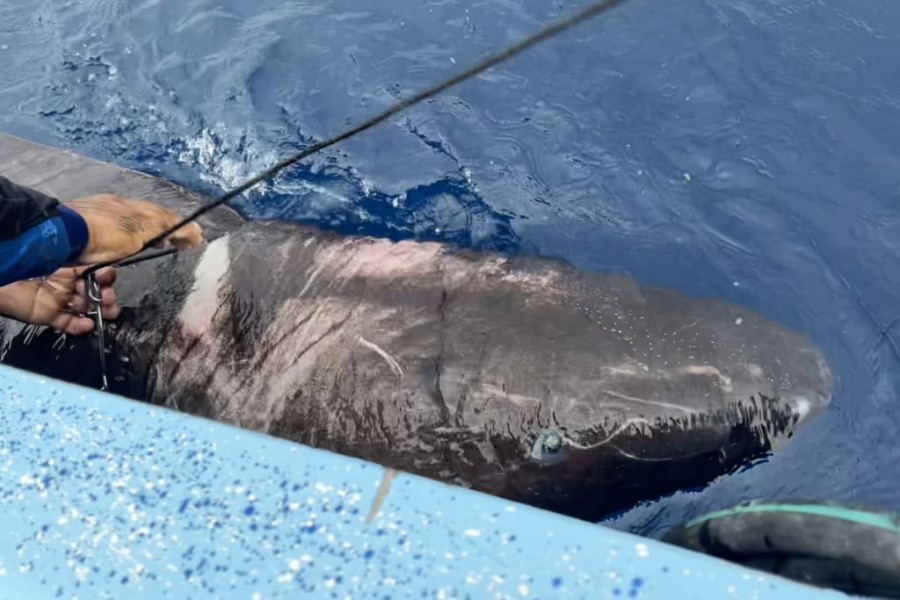A half-blind shark that is typically thought to live in freezing Arctic waters, scavenge on polar bear carcasses and survive for hundreds of years, recently turned up in perhaps an unexpected place — a coral reef off Belize. This marks the first time a shark of its kind has been found in western Caribbean waters off the world’s second longest barrier reef.
Devanshi Kasana, a Ph.D. candidate in the Florida International University (FIU) Predator Ecology and Conservation lab, was working with local Belizean fishermen to tag tiger sharks when the discovery was made. It had been a long night of fishing. By dawn, the weather had deteriorated. Storms were gathering on the horizon. The team did a last check of their lines. On the other end of one, wasn’t a tiger shark, but a rather sluggish creature. It looked old — ancient, even — and more like an elongated, smooth stone that had sprung to life. It had a blunt snout and small pale bluish colored eyes. All together, these clues led scientists to think it was a member of the sleeper shark family.
“At first, I was sure it was something else, like a six gill shark that are well known from deep waters off coral reefs,” Kasana said. “I knew it was something unusual and so did the fishers, who hadn’t ever seen anything quite like it in all their combined years of fishing.”
Kasana texted Demian Chapman — her Ph.D. advisor and Director of Sharks & Rays Conservation Research at Mote Marine Laboratory & Aquarium — to share the news. She also sent along a photo of the shark. Chapman’s response caught her off guard. He said it wasn’t a six gill. But, it looked a lot like a Greenland shark (Somniosus microcephalus).
After conferring with several Greenland shark experts, the final determination was it was definitely in the sleeper shark family — and because of its large size most likely a Greenland shark or a hybrid between the Greenland shark and Pacific sleeper shark (Somniosus pacificus).
Greenland sharks remain somewhat of an enigma to science. What is known about them is they tend to be seen in the frigid waters of the Arctic and North Atlantic oceans. The slow-moving species is also slow growing. Yet, a life in the slow lane may benefit them, because they have been estimated to live upward of 400 years — earning them the special designation of longest-living vertebrate known to science.
Because little is known about them, that means nothing can be definitively ruled out about the species. Greenland sharks could possibly be trolling the depths of the ocean all across the world. In fact, experts speculate that they could be found all over the world, living in tropics at greater depths, where they can find their preferred low temperatures.
The waters where Kasana and the fishermen found the shark certainly get deep. Glover’s Reef Atoll — part of the Glover’s Reef Marine Reserve World Heritage Site, a marine protected area (MPA) — sits on top a limestone platform, forming a lagoon surrounded by a coral reef. Along the edges of the atoll there’s a steep slope that drops from 1,600 feet to 9,500 feet deep, which means there is cold water needed for a Greenland shark to thrive.
For nearly two decades, Chapman has led projects tracking shark populations at Glover’s Reef. The data has been shared with the Belize National Shark Working Group — a team made up of government officials, shark fisherfolk, non-governmental organizations, and scientists. This work recently led to increased protection and new legislation prohibiting shark fishing two miles around all three atolls in Belize, including Glover’s Reef Atoll.
Ellen DeGeneres’s The Ellen Fund, through the Endangered campaign, provides support for Mote, FIU’s Predator Ecology and Conversation lab, the Belize Fisheries Department and the shark fishing communities to expand on the shark monitoring efforts, focused on reducing shark catch and protecting shark populations. Part of the funding supports Kasana’s Ph.D. research, tagging tiger sharks to track their movement and find strategies to best manage their populations since they are an important species in the Belizean fishery. Check out Chapman’s appearance on The Ellen DeGeneres Show from early 2022 below.
“Great discoveries and conservation can happen when fisherman, scientists and the government work together,” said Beverly Wade, Director of the Blue Bond and Finance Permanence Unit in the Office of the Prime Minister of Belize. “We can really enhance what we can do individually, while also doing some great conservation work and making fantastic discoveries, like this one.”
“I am always excited to set my deep water line because I know there is stuff down there that we haven’t seen yet in Belize, but I never thought I would be catching a Greenland shark,” said Omar Faux. “My crew and I are looking forward to future deep water expeditions with Dr. Chapman and his team.”
While Kasana and the team weren’t expecting to ever see a Greenland shark, finding one shows how partnerships can oftentimes pave the way for unexpected and intriguing new discoveries.
Chapman says he’d buy some lotto tickets if they catch another sleeper shark. But, if it happens, the team is ready. One of the world’s top experts on Greenland sharks — University of Windsor Associate Professor of Biology Nigel Hussey — gave the team four satellite tags. That way, if lightning does strike twice, they’ll be ready — and one step closer to finding how these sharks live in the tropics.
The findings were recently published in the journal Marine Biology. In addition to the Ellen Fund, the research was also supported by the Georgia Aquarium and the Roe Foundation.


